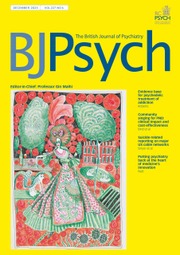No CrossRef data available.
Article contents
Estimating the smallest worthwhile difference of recommended psychotherapies for depression: observational study
Published online by Cambridge University Press: 10 November 2025
Abstract
The smallest worthwhile difference (SWD) represents the smallest beneficial effect of an intervention that patients deem worthwhile given the harms, expenses and inconveniences of the intervention. The SWD facilitates interpretation of the patient-perceived importance of intervention effects. We previously estimated the SWD for antidepressants for depression, but the SWD for psychotherapy remains unknown.
To estimate the SWD of recommended psychotherapies for depression compared with no treatment.
We estimated the SWD through a patient required difference in response rates between psychotherapy and no treatment after 2 months. We recruited using Prolific, an online cross-sectional survey platform, in the UK and USA in January 2025. We also queried a random subset of respondents to replicate our previous SWD estimation for antidepressants.
In the primary study, we recruited 526 participants (mean age: 36.7 years (s.d. = 12.5); 54% women and 61% White individuals). Of these, 6% reported that they would not initiate psychotherapy with a 100% treatment response. For those willing to initiate psychotherapy, 87 reported moderate-to-severe depressive symptoms but were not in treatment, 184 were in treatment and 131 reported absent-to-mild symptoms with or without previous treatment. The median SWD for people with moderate-to-severe depressive symptoms, not in treatment and willing to consider psychotherapies was a 20% (interquartile range: 10–35%) difference in response rates comparing psychotherapy with no treatment. This was similar to the SWD for antidepressant drugs (SWD = 20%, interquartile range: 10–30%; n = 104). Participant characteristics were not meaningfully associated with the SWD.
Current empirically supported psychotherapy response rates of 15% were sufficient for one in three people to initiate psychotherapy given the burdens, but two in three expected greater treatment benefits or fewer burdens. The SWD for psychotherapy was not materially different from the estimated SWD for antidepressants. Individual patient value judgements and preferences merit greater attention. These findings should be replicated with diverse samples from different geographical locations.
Keywords
Information
- Type
- Original Article
- Information
- Copyright
- © The Author(s), 2025. Published by Cambridge University Press on behalf of Royal College of Psychiatrists



eLetters
No eLetters have been published for this article.